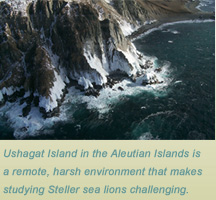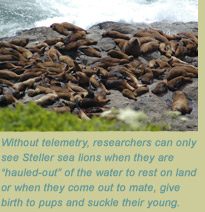 Why We Use Telemetry
Why We Use Telemetry
Telemetry helps scientists study animals where they cannot directly observe them. Ushagat Island, Alaska, home to Steller sea lions, sea otters, killer whales, and harbor seals is one of these isolated places. These marine mammals are connected with each other in food webs that affect their survival. Many of these populations are declining, including the Steller sea lion. Steller sea lions spend a large part of their lives at sea or hauled-out on land in remote areas. Telemetry allows researchers to study Steller sea lions around the clock, anywhere on the planet, in any type of weather, and, most importantly, underwater.
 In 2001, Dr. Markus Horning, then at Texas A&M University, followed by Oregon State University and later the Alaska SeaLife Center (and now with Wildlife Technology Frontiers) and
Dr. Jo-Ann Mellish (then at the Alaska Sea Life Center) started a long-term study of the population ecology
of Steller sea lions in remote locations like Ushagat Island using satellite telemetry tags called Life History Transmitters (LHX).
They want to learn why the Steller sea lion population is not recovering in some regions by discovering how Steller sea lions are dying.
The population of Steller sea lions has declined from 300,000 to 75,000 individuals worldwide.
Western Steller sea lions in the Gulf of Alaska and Aleutian Islands are currently listed as endangered under the Endangered Species Act.
LHX tags are helping to determine their cause of death and hopefully a clue to their recovery.
In 2001, Dr. Markus Horning, then at Texas A&M University, followed by Oregon State University and later the Alaska SeaLife Center (and now with Wildlife Technology Frontiers) and
Dr. Jo-Ann Mellish (then at the Alaska Sea Life Center) started a long-term study of the population ecology
of Steller sea lions in remote locations like Ushagat Island using satellite telemetry tags called Life History Transmitters (LHX).
They want to learn why the Steller sea lion population is not recovering in some regions by discovering how Steller sea lions are dying.
The population of Steller sea lions has declined from 300,000 to 75,000 individuals worldwide.
Western Steller sea lions in the Gulf of Alaska and Aleutian Islands are currently listed as endangered under the Endangered Species Act.
LHX tags are helping to determine their cause of death and hopefully a clue to their recovery.
Reasons why we use telemetry:
- Steller sea lions in the Gulf of Alaska and the Aleutian Islands have declined by as much as 75% in the last 40 years. Researchers are looking for clues to understand this decline and help their recovery by studying how Steller sea lions are dying.
- Steller sea lions that do not breed or that die at sea are unlikely to ever be seen. These unseen animals are critical to learning why the population is not recovering.
- Steller sea lions are not easy to capture. Adult males can weigh as much as a large truck and can become aggressive when cornered.
- Steller sea lions’ habitat and territory are complex, and they interact with many different organisms including orcas and sharks in the food web.
- Since they live in remote areas, scientists know surprisingly little about their life history.